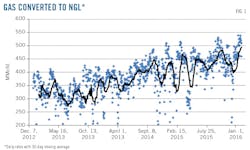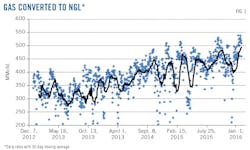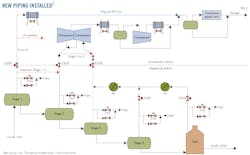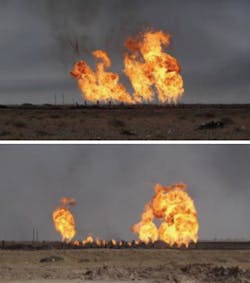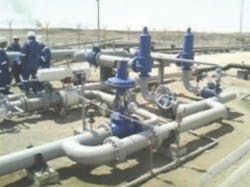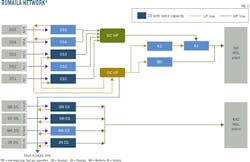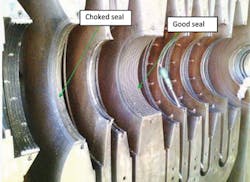Plant, pipeline reconfiguration boosts Iraqi NGL yield
Anders Carlsson
Sajid Jabbar
Basrah Gas Co.
Iraq
Natural gas intake at NGL plants in southern Iraq doubled to roughly 500 MMcfd between 2012 and 2015 thanks to plant reconfiguration and completion of a low-pressure pipeline. An inability to process sour gas and declining reservoir pressure in Rumaila field, both of which these projects addressed, had been eroding NGL-plant intake.
Basra Gas Co. (BGC) was formed in May 2013 to restart investment in Iraq's gas infrastructure. As a result of sanctions and conflict over the past 30 years, southern Iraq suffered from a lack of infrastructural investment and much of its natural gas was being flared as of September 2013.
BGC operates compressor stations attached to each crude degassing station (DS), compressing the available gas from each stage and sending it to two centralized NGL-extraction plants via roughly 1,800 km of pipelines. Each of the NGL extraction plants uses propane refrigeration to cool the natural gas and condense the NGL, which is separated for local use by distillation into LPG (propane and butane) and natural gasoline (pentane and heavier).
BGC operates a storage and marine terminal on the Persian Gulf coast at Umm Qasr, storing LPG and condensate for distribution in the domestic market. In the future, excess products could be exported through the marine terminal once local demand has been met, bringing additional revenue to Iraq.
Fig. 1 shows the increased Iraqi use of gas as an NGL feedstock. Daily averages exceeded 520 MMcfd as of September 2015. This article examines how this increase occurred in just a few years.
Gas-processing crossovers
Fig.2's simplified process-flow diagram shows a typical degassing station with associated gas compression. There are nine such stations in the Rumaila field, each with multiple degassing banks and multiple compressors. Oil from wells gathers in manifolds at each degassing station and is routed to degassing banks. Each degassing bank routes oil to the Stage-1 degassing vessel, which in original design operated at a pressure high enough to send all Stage-1 gas directly to the NGL plants without compression. Stage-1 gas makes up 70-80% of total associated gas from all degassing stages.
Well design governed operating pressures until 2003 when reservoir management was sacrificed in favor of production. Insufficient new drilling or water reinjection to replace extracted oil led to lower reservoir pressures. Roughly half of all Stage-1 gas no longer reached NGL plants by 2012 as a result, with only 10% getting there by 2015. The original high-pressure (HP) path for Stage-1 gas appears in blue in Fig. 2.
In response to the drop in pressure of available Stage-1 gas, BGC installed new piping to crossover Stage-1 gas into Stage-2 gas (red line in Fig. 2) routed to existing compressors. The Stage-1 gas, however, is of relatively high-mass flow and relatively low molecular weight. Compressors could not deliver the necessary discharge pressure with Stage-2 gas to the Stage-3 compressor inlet via another crossover.
Resulting elevated K3-LP compressor suction pressure made it impossible to capture third-stage gas while operating in this mode. This gas was sacrificed. Operating in this low-pressure (LP) mode, Stage-1 gas became roughly 85% of the total, while Stage-3 gas was about 3.5%, making it worth sacrificing Stage 3 to capture Stage 1 despite 3's richer composition. Crossovers such as these were installed at nearly all the Rumaila field's degassing-compressor stations.
Fig. 3 shows the reduction in flaring after installation of a crossover at South Rumaila Markazia degassing station. Fig. 4 shows a crossover with the control valve, shutoff valve, and relief valves required for control of the high-low pressure interface.
Rumaila low-pressure network
Installation of the described crossovers occurred on one of three degassing banks at each station. Flexibility for oil production soon required a more robust solution to cope with a mix of gas available at different pressures from different degassing banks. Localized compression capacity also was not always matched with available gas volumes.
The simplified process flow diagram of the Rumaila LP network shows how each compressor station is connected both to a high-pressure network, which discharges gas to NGL plants, and to a low-pressure network which distributes gas for compression within the Rumaila field (Fig. 5). The LP network is a backbone along the inline compressor stations in South Rumaila (Fig. 5, bottom half), taking LP gas from all stations and delivering it to each compressor, regulated by inlet pressure control valves.
Both the high pressure and low pressure pipeline networks were operational prior to 2012, and the novel approach in this case was to operate them at different pressures and use the low pressure network to distribute compression capacity.
In North Rumaila (Fig. 5, top half) the LP network looks more like a spider web because the compressor stations (CS) are spread more radially around the NGL plant. The NGL plant itself has an HP slug catcher (S/C) and LP slug catcher. North Rumaila (NR) LP network compression is augmented by inlet booster compression (IBC) which helps in taking low-pressure gas and boosting it to optimal pressure for NGL extraction.
A key element of the LP network at the NR NGL plant is the addition of a connection from one set of inlet booster compressors' outlet (K2) to the other set of booster compressors' inlet (K1), allowing them to run in series rather than in parallel. This design element required reconfiguration of the K2 compressors to run at pressures below their original design envelope.
All the piping for the low-pressure network in NR was already in place before 2012, and was originally designed to segregate rich gas generated in degassing Stages 2, 3, and 4 from Stage 1's relatively lean gas. The Stage-2, -3, and -4 gas was preferentially routed to NGL extraction while part of the lean Stage-1 gas bypassed NGL extraction, depending on capacity constraints. The drop in reservoir pressure made it economically favorable to change operating modes such that one network was used at low pressure to distribute compression capacity, while the other was used at high pressure to transfer gas to the NGL plant.
Temporary compression
In 2015 the Iraqi State Co. for Oil Projects (SCOP) was still building compression stations in the Zubair field for associated gas removal from existing degassing stations. Similar to Rumaila field, enough Stage-1 gas pressure had been lost to prevent gas from reaching the NGL plants without additional compression.
BGC in 2013-14 had installed temporary compression in the Zubair field at Rafidiya (two compressors), Hammar-Mishrif (four compressors), and Zubair-Central (four compressors) degassing stations, resulting in an additional gas capture of about 110 MMcfd. Reciprocating two-stage gas engines drive all of these compressors, delivering 10-15MMcfd each, depending on ambient air temperature and available suction pressure.
Compressor rehabilitation
In 2012 only 12 of 20 centrifugal compressors in North and South Rumaila were operational, due to cannibalization for spares. By 2015 BGC had rehabilitated the remaining 8 compressors, restoring much of the site's original design capacity. Several of the rehabilitated compressors were operated in modified low-pressure mode, taking relatively lean Stage-1 gas as described above.
BGC also overhauled more than half of the operating compressors. Oil carryover from upstream degassing vessels far exceeding the design capacity of intermediate separators typically damaged the compressors. This carryover included sand, damaging the aluminum seals separating one pressure stage from another (Fig. 6).
Seals normally lasting 3-5 years can be destroyed by one carryover event and a complete compressor overhaul for repair takes many weeks. Damaged internal seals lead to unintentional internal recycle and reduced compressor capacity.
Sour-gas processing
While the Khor Al Zubair (KAZ) NGL extraction plant accepts only sweet gas from Zubair and South Rumaila, the NR NGL plant has a Sulfinol unit to treat gas from North Rumaila and West Qurna with up to 1,500 ppm sulfur. BGC rehabilitated the Sulfinol unit, which had been idle for decades, upgrading H2S detectors, relocating vents and drains, and testing safety-critical equipment. Staff was trained and equipped with portable H2S detectors and given breathing apparatuses for specific tasks. The laboratory also began analyzing sour gas and liquid samples for process optimization and product quality control.
BGC in 2012 resumed work on a partially completed 40-in. OD low-pressure gas pipeline from the West Qurna field to a new IBC station at the NR NGL plant. By mid-2015 this pipeline was operational and delivering 80 MMcfd of sour gas to the plant from DS-7 and DS-8, marking the first time gas was captured from the West Qurna field and greatly reducing flaring.
The ability to treat sour gas at NR NGL allowed additional volumes to be introduced from various NR stations, which previously had segregated sweet and sour oil. By late 2015 CS3 was compressing 20 MMcfd sour gas and CS4 and CS5 were being readied to take an additional 50 MMcfd.
Plant flaring optimization
The following actions reduced flaring from NGL plants between 2012 and 2015:
• Several passing valves were replaced.
• Emergency depressuring-valve bypasses which had been left open to keep flares lit were closed.
• Ignition gas kept a pilot flame lit while the main pilot systems were fixed.
• Efforts were focused during operations to track sources of flaring when additional flame was observed.
Savings from the KAZ plant totaled an estimated 20 MMcfd. At gas turbine thermal efficiency of 35%, this equals 100 Mw of electric power for Iraq, enough for 45,000 air conditioning units.
The authors
Anders Carlsson ([email protected], [email protected]) is process engineering and production optimization manager at Basra Gas Co., Basra, Iraq. Early in his career he worked as a research scientist in Taiwan and Germany, then worked for Royal Dutch Shell in various positions in the Netherlands, England, and Nigeria. He has worked in design, commissioning, startup, performance optimization, and operations for gas and LNG plants. Carlsson holds a PhD (2001) in chemical engineering from Stanford University, Palo Alto, Calif.
Sajid Jabbar ([email protected], [email protected]) is director of gas compression and treatment at Basra Gas Co., Iraq. He has 30 years of experience in Iraq's oil and gas sector, including commissioning, startup, operations, and asset management. Jabbar holds a BS (1982) in petroleum engineering from Baghdad University.
